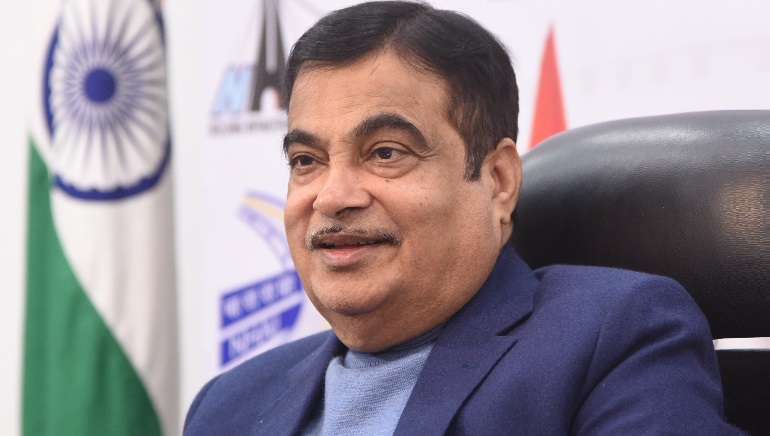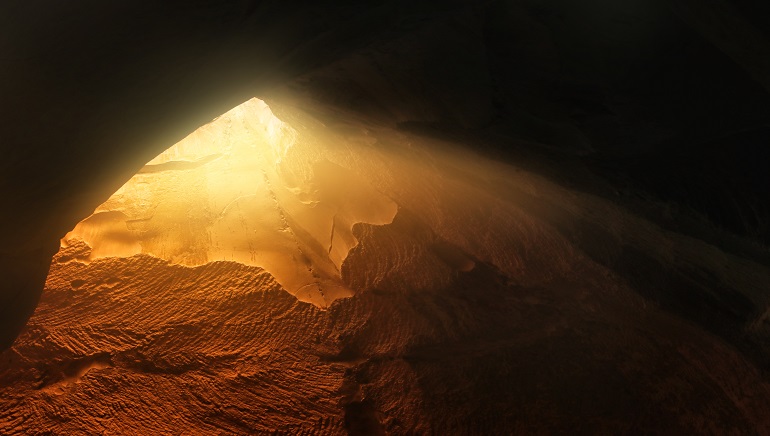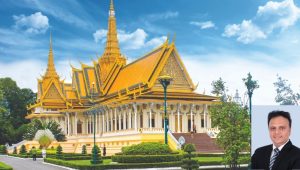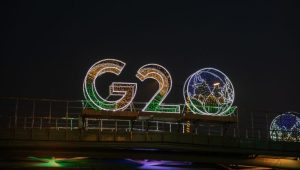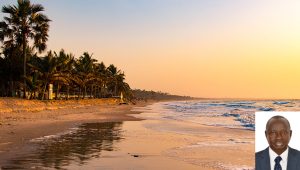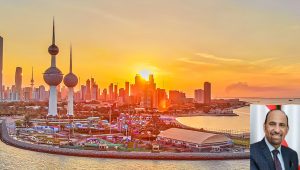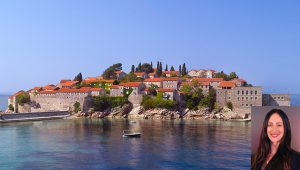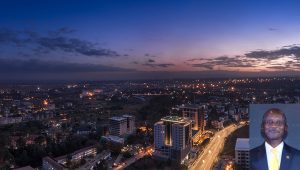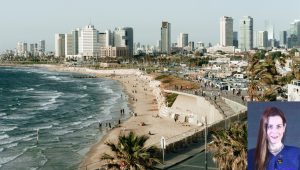Q. Hon’ble Minister Sir, we really appreciate the fact that you are popularly addressed as the Infrastructure Man of India and are even nicknamed as ‘Roadkari’ and ‘Flyover Minister’ owing to your great vision with regard to national development through which you have totally transformed the transport infrastructure landscape in the country today. Please share with our viewers some of the key strategies which you have employed to emerge as the top-performing minister in the Modi Government.
A. Actually, infrastructure is the heart of developmental for every country of the world. I always remember the famous statement from the American President John F. Kennedy, that “American roads are not good, because America is rich, but America is rich, because American roads are good” and the prosperity is coming from the road – water, power, transport and communication – these 4 things are very important without which we cannot develop industry. Without industry, we can’t get foreign investment or capital investment. And without that, we cannot create employment potential, we cannot get more market, more export and without that, we cannot increase growth. So, for sustainable growth, it is very important that you develop good infrastructure, water, power, transport and communication. Regarding the transport sector, India has a huge potential. It is the fastest growing economy and one thing which is very, very clear, is that the number of people, particularly the population and the number of vehicles every time have been increasing. And that is the reason that we need expansion of roads. So, we are making Green Express Highways. We are making New Express highways, we are converting existing roads into six lane, eight lane.
Today, I just attended the inauguration function of Suzuki in Noida and took the Delhi Metro Express Highway – the 14 lane road. I don’t know whether you know it or not – 3 years ago there was a usual traffic jam there. But today the traffic is smooth. So it was a great pleasure for me to see that. It was exactly the same for Meerut to Delhi route, which was earlier covered in 4 and a half hours. Now people are commuting in 45 minutes. Earlier Delhi to Dehradun was 8-9 hours. Now people are commuting in 3 hours and I’m making new roads to Dehradun from Akshardham, where travel time will be around 2 hours; 2 hours Delhi to Dehradun, 2 hours from Delhi to Haridwar, 2 hours from Delhi to Chandigarh, 2 hours from Delhi to Jaipur, and 4 hours from Delhi to Amritsar and 6 and a half hours to Srinagar and Jammu.
So the way in which the infrastructure is being developed in the country now, it is really a great thing which is important for trade, business, industry, every sphere good roads are very important. Good roads are not only the roads, but they are the growth engine for the economy. And that is exactly the vision when I’m working on this subject and I’m confident that in due course of time, we are the fastest growing economy. The mission of our country is to make the Indian economy as Aatma Nirbhar (self reliant) as possible. And 100% we are on that path, I assure you that we will develop the infrastructure in India at par the infrastructure of European standard, US standard and within 3 years, we will be equal to them. That is exactly the mission! When I took charge as the Minister, the development rate was 2 kilometer per day. Now it is 38 kilometers per day. We have already succeed in making world record, one in Mumbai-Delhi Express Highway, it’s a big highway, the longest highway in the world – of 1350 Kilometer Mumbai-Delhi, within 12 hours you can come from Mumbai to Delhi and that highway in Vadodara, Mumbai Delhi highway in Vadodara section, one part where we have completed 2.5 Kilometer four-lane Portland cement concrete road in 24 hours, it’s a Guinness Book of World Record, just see the distance!
The second important thing is that we already made world record in Bijapur-Solapur Road, one lane bitumen road spanning 26 kilometers was constructed in 22 hours. We are making 38 kilometer per day and our road construction is highest in the world. So, this is the thing, the way in which the infrastructure is changing. And I’m confident that it is not only that the infrastructure is changing, but the infrastructure is changing the economy of the country.
We have already (it’s not my department) but we have already successfully implemented 100 New airports, we are taking the trial of big aircraft, we use road as airstrip in Rajasthan near Pakistan in Jalore area. So everywhere we are now making logistic parks, we are making 35 logistic parks in the country. At the same time we are moving towards e-vehicles, I’m in charge for that we want to make our present import of fossil fuel is eight lakh crores my idea is to make Ethanol, Methanol, biodiesel, bio-CNG, LNG, electricity, and green hydrogen as the fuel. My aim is that we need to encourage the Indian people to make an Indian fuel in India. We aim to promote Swadesi and that is important for the country and we are planning for that.
And I’m confident that we will succeed in that now, we are launching electric cars, electric bikes, electric two wheelers and three wheelers, electric buses, then also we are working on green hydrogen, we are working on battery chemistry, and not only that of lithium ion but steel ion, aluminum ion, then Zinc ion. Everything we are making the research is on it at the IITs (the research institution) and regarding Green Hydrogen – my dream is to make India as an exporter of Green Hydrogen to the world. Presently, the size of our petrol industry is 7.5 lakh crores and within 5 years, we will make it 15 lakh crores and we will be the number one manufacturing hub of automobiles in the world.
All big reputed brands now are present in India, we are developing vendors, the raw material developed because of the scrapping policy, the copper, aluminum, steel, rubber, plastic will be available with 50% cost and that is going to reduce the cost of production for the automobiles and we can be more competitive in the international market. So, the way in which we are moving I’m confident that we will be 100% successful in this mission to make India as ‘Aatma Nirbhar Bharat.’
Q. Sir, you have come a long way from being the State Minister of Maharashtra, where, under your leadership, a series of roads, highways and flyovers across the state were constructed – including the Mumbai-Pune Expressway, India’s first 6-lane concrete, high-speed expressway. Today, you have the credit of changing the face of the nation with major infrastructure development projects being completed at a record speed. Please share with our readers any one special project which is close to your heart and why?
A. Actually, we’re making a lot of projects now, we’re making 26 Green Express Highways. Delhi Mumbai Express Highway, the costing is one lakh crore, we are making Chennai Bangalore Express Highway. We are making lot of Express highways in the country starting from Uttar Pradesh, Bihar, Arunachal, Meghalaya, Tripura, everywhere. So I’m confident that we are adding value through our work, be it in Arunachal Meghalaya, Tripura or even in Jammu Kashmir, we are making Zojila Tunnel, where we save 5000 Crore rupees on that project, that tunnel they say is 13.5 Kilometer (highest in the Asia) and just near to Kargil Valley, we are making that connecting Ladakh, Leh to Sri Nagar. So, we are making only the tunnel project of two lakh crores in the country. We’re making Chardham project, all season connectivity to Badrinath, Kedarnath, Gangotri and Yumnotri. We are making to Maan Sarovar from Pithoragad, Uttrakhand where 80% of work has been already completed. So these projects are of great pride for the country. And every project is a pride for me. Every project is for my country, and I got an opportunity to do something for the people. I’m doing it. I’m happy that 100%, the people expectation is very, very important and to fulfil the expectations of the people is the mission of our government under the leadership of our prime minister and we are working fast on that.
Q. Sir, with regard to the current scenario, what are your views on our Hon’ble Prime Minister’s call for “Vocal for Local” and “Atmanirbhar Bharat”? Please also throw light on the ways in which you plan to further this agenda.
A. Already our sector will create a lot of employment potential. Now our construction equipment machinery industry is increased by four times. Now my idea is to use biofuel, alternate fuel, electric in the construction machinery. One of the reputed companies has now started production, we’re making electric trucks. We want to make e-highway. So anywhere in the sector now we want to do develop industrial clusters, logistic bars near to road by which we can contribute for our economy. So 100% new innovation, new research, new policy is the strength of my department. I always keep telling the people that Innovation, Entrepreneurship, Science, Technology, Research, skilled and successful practices, we name it as knowledge and conversion of knowledge into wealth is the future. And a second important thing, which we are always insisting on is that no one is the best, it is depending upon the leadership, the vision of leadership and appropriate technology, you can convert waste into wealth, we are using waste plastic, waste rubber, we are using now steel fiber for making of strong bridges in precast, earlier we weren’t using steel fiber, today, we are using soil stabilizing technology. So, the different technology by which we are developing, I am confident that 100% our people our engineers are very, very competent, and India has got the highest manpower of engineering talented youth in the world. So, there is a huge opportunity and I really feel that we are very much confident that we will succeed in this call.
Q. Sir E-vehicles are the future for the world and will surely help in containing pollution in countries where emissions are high; especially in Asian countries like India where demand is going to be high for both 2 wheeler and 4 wheeler E-vehicles. What roles and expectations can the industry and consumers have from your Ministry for this future mode of transport?
A. Actually, frankly speaking, the future of E vehicle 100% is very bright. Now, for example, if you have a petrol car going by petrol car the cost is 10 rupees per kilometer, going by a diesel car is seven rupees per kilometer and moving by electric is one rupees per kilometer and within two years, the cost of petrol car and electric car will be the same. We are now adding flex engine technology already in Brazil, US and Canada they have a flex engine. The meaning of flex engine is that you can use 100% petrol or 100% bioethanol. So, we are encouraging the ethanol industry from sugarcane juice, molasses, from rice, from corn, food grain, we are making bio-ethanol, we have surplus sugar, surplus wheat, surplus rice, surplus corn, we are facing crucial problem in agriculture. So, diversification agriculture towards energy and power sector is our plan. So, 100% electric, ethanol and green hydrogen is the future and we are working on that and I feel that within two years total picture will be changed. Already there is more than expectation rise in e-vehicles, two wheelers, three wheelers, cars and buses or public transport now, and one of the companies is making luxury buses on electricity. So, 100% within two years, the cost of diesel bus will be equal to cost of electric bus. No one will purchase diesel. And the pollution is a big concern. The ethics, economy, ecology and environment, these are the four important things for all of us, out of which ecology and environment is very important. We’ll take just take the example of Delhi, because of air pollution, what type of problem Delhi people are facing. So this is the time for the country, for the society, for the government to think seriously on air pollution, water pollution and sound pollution. And I’m working hard on these 3 particularly important subjects and 100% as far as the international benchmark is concerned and already the Prime Minister has given us a task for 2070 zero emission, after we have successfully implemented the Euro VI emission norms in the automobile sector. So, I am confident that the things are moving now, in our power basket, 38% of the power in the solar power, we are encouraging solar power, hydropower, then green power, by wind power and 100% I’m confident that for green, we are very much committed and ecology and environment is the mission for us. We want development, but at the same time we have to protect ecology and environment that is the highest priority for all of us.
Q. Sir, we acknowledge the fact that the Indian Automobile Industry is generating the highest number of jobs, exports and revenue to state and central governments. Your vision to make the Indian automobile industry the number one in the world, for export of electric vehicles including electric cars, scooters, buses, auto rickshaws and trucks, in 5 years time, is indeed commendable. Please elaborate.
A. Actually the scrapping policy is already implemented. Just today, I inaugurated the scrapping center of Suzuki and Toyota in Noida, now, it is already started by which we will reduce the cost of components, the 50% cost of the raw material will be reduced copper, aluminum, steel, rubber and plastic by which we will be more competitive in the international market. So, now we have a lot of scrapping vehicles available and even will allow the scrapping vehicles from abroad like Indonesia, Malaysia, then even from Nepal, Bhutan, Bangladesh, we can get this as we have already included the drop power port in Tuticorin, Kandla and even in Jawaharlal Nehru Port by which we will receive the big size of the ship, Panama-size ship by which two tons of material will be transported.
So, 100% the price economics is there, by taking all this scrapping material from the world, we will be again making the recycling of that material, our components cost will be less, we will be more competent to international market. The present size is 7.5 lakh crore of this industry and we want to make it 15 lakh crore. Now, in India, our two wheelers, Bajaj Hero, TVS, 50% of two wheelers we are exporting. So, there is a huge potential. Maruti is exporting the car from India, even the Mercedes, BMW all are now here, our tractors are popular in the world. So, this is the opportunity for the Indian automobile industry to increase their volume by reducing the cost, and the government is supporting them.
Q. Sir, under your praiseworthy leadership, today India is constructing roadways at a record speed – the fastest not only in Asia but the world! What are your suggestions for private sector companies and may be other ministries so as to how they may use this development for further prosperity? In other words, in which ways road development can further prosper economic development of the nation?
A. 100%! Water, Power, transport, and communication is very important and as far as the transport sector is concerned, the waterways, roadways, highways, e-ways and at the same time airports. At the time when I was the Shipping Minister, we launched this amphibious seaplane where seaplane can land on the airstrip at the same time on the water also, that was also launched by me. So, I’m confident that there is a lot now that we want to make it a public transport on electricity like Hyperloop, roadway, cablecar funicular railways now, with my department, we want to encourage the people particularly in hilly area, in place of taking bus taking, time consuming diesel, creating pollution, in place of that directly there will be a ropeway, cablecar, funicular railway. We are already in considering the proposal. 20 proposals are there from Himachal Pradesh we have a lot of proposals from Uttarakhand, Kashmir, we are working on them.
Q. Sir, under your exemplary leadership, the Ministry of Road Transport and Highways has constructed 13,394 km of highways in the fiscal year 2020-21. We, at AsiaOne, really appreciate the fact that the pace of highways construction in the country has touched a record 37 km per day in the financial year 2020-21 despite the ongoing Covid-19 pandemic. Please share with our readers the mantra for your outstanding success!
A. Actually, this is not the success of an individual Nitin Gadkari. This is a success of team spirit. I always tell it to my people that a square and b square, its total is a square plus b square. But when A and B comes together, thinks together, converse together A plus B bracket square equals to a square plus b square plus twice A B. And this twice AB is the top collective team spirit. I always support my engineers, my officers and contractors. I resolve their problems. I have always taken review meetings and created a spirit that we have worked for the country. You got the opportunity to work for the people, work for the country. And that was exactly the spirit behind it. Because I’m not an engineer, but in 1995 I was a PWD Minister in Maharashtra, I got a call to construct Mumbai Pune expressway, Bandra-Worli sea link project, 55 flyovers in Mumbai. And because of that my name was now linked with the infrastructure. But I’m not an engineer. I’m not an expert. But inspiration and motivation to work for the country is there. That is the mission. And after that Atal ji gave me an opportunity to appoint a committee under my leadership. I got an opportunity to make Pradhan Mantri Gram Sadak yojna. That was the report I had given to Shri Atal Bihari Vajpayee ji at that time. At that time I prepared one report for NHS. And today I’m the Minister at this department.
So as I always say that there will be some people who get the opportunity. And that is very important. Some people convert opportunities into problems and some others convert problems into opportunities. My experience is to convert problems into opportunities. That is exactly my strength. Neither I’m a knowledgeable man, neither I’m an expert engineer, neither I’m an economist or a chartered accountant. I’m a very, very common person who gets the opportunity to do something for the country. I’m doing it.
I kept on getting the opportunities, and I kept on working. And I didn’t get time to calculate how much work I have done and the credit given for it. I am a workaholic and want to do something for my country. If I get time after managing my family and home, then we have to contribute to this nation, ‘Mathrubhumi.’ ‘Hum Do Chaar Rahe na Rahe, Par Tera Vaibhav Rahe Ma,’ this is the learning that we were taught in the RSS.
That is the spirit that we have to work for the country, we have to work for the society. The people who are socially, economically, educationally backward, those who don’t have house, food, shelter, and cloth on the their body, we need to work for them. That is the socio-economic thinking behind Pandit Deen Dayal Upadhayay’s Antyodaya. That is the spirit when all of us, we are working, ‘Charewati, Charewati – Chalte Raho’, now you people are important people who can analyze the thing, who can make the review who can make the auditing, I am always telling to people the financial audit is very, very important, but the performance audit is more important than financial audit. In government, it is very important, it needs positivity, transparency, Fast Track decision making process and corruption free system. I have already awarded more than works of more than 50 lakh crores in the seven years from our own Ministry, but there is not a single allegation from anybody about corruption. We are very transparent, very quality approach we have and we are very committed for the development. This is a development of our country. This is the asset of our country, asset of people, that is the spirit in way which we are working.
There are many people who had worked more than me and I guess I haven’t worked that much. But I feel I play cricket. So, I really like one-day cricket. At that time there were players like Dileep Vengsarkar, Sandeep Patil, Sachin Tendulkar who score at every ball. So life should be like that only. One has to play even with cross bat and score a boundary to make a record.
Q. As a Leader who leads by example, you yourself use an EV and have been an ardent advocate of the production of biofuels (Bio-Diesel, Bio-CNG, Bio-Methanol, Ethanol) in the country by using the stubble of certain crops to reduce the dependence on the import of crude oil and fuel gases. In fact you have asserted that India’s automobile sector can become the number-1 in the world in the next five years by using alternative fuel sources. What all policies and initiatives do you plan to bring about to further this agenda?
A. Already ethanol policies are there, they’re making ethanol from sugarcane juice, ethanol from molasses, ethanol from BAV molasses, ethanol from corn, ethanol from Rice, ethanol from wheat, food grade. Now, the second generation ethanol from biomass already there, even we can make five ton of ‘parali-rice straw’ is giving one turn of bio CNG. We can make Bio-LNG because LNG in transport is easy. So, now the projects are started. So the way in which now my own tractor we have converted it to Bio-CNG. We are saving one lakh rupees per year in place of diesel and even the pollution is negligible. So this is the time for e-vehicles, and using ethanol, methanol, biodiesel, CNG, electric and green hydrogen for long term transport. We can use LNG as a fuel. If suppose one diesel truck converts into LNG, the cost is 10 lakh rupees, and you will get your money back within 295 days. So, this is the economics. So, the technology is very important. And every time whatever the successful practices in the world, the best technology, we have to conduct research on it, and we have to accept that it is the way by which we can make socio-economic transformation. And we can increase the growth rate, we can create more employment potential, and we can eradicate the poverty.
Q. Sir, please throw light on National Automobile Scrappage Policy.
A. Actually, frankly speaking, the policy has already been passed. Now it is to be well received by the industry. And today (23rd November’21), I also inaugurated one scrapping center of Suzuki and Toyota; one centre of Mahindra is there. Already 100s of new scrapping centres are in the process. And I’m confident that the capital cost is not more than 30-35 crore. So it can give you the golden opportunity for employment. It’s a profitable industry, huge potential is available at the fitness centers, scrapping centers, driving training centers. Our plan is to expand all these initiatives by taking the private sector into confidence. We want to start this and we are in the process and people are giving a good response. 100% I’m sure, probably within two years, there will be a lot of things on the cards.
Q. We, at AsiaOne, value your contribution in making India one of the greatest brands in the world with world-class infrastructure amenities – making it a popular investment destination. In fact you are a role model for umpteen others especially the business community who look up to you for inspiration. What’s your message to them?
A. India is the best destination for investment. Actually, whatever the return you are getting in dollars, the interest cost is 1%-2%. In India, it is 6-8%. So, Indian scenario returns are good. My suggestion and request to all of the investors particularly from abroad that invest in stock exchange. Now, the MSMEs are also on the stock exchange and India is the fastest growing economy. India’s exports are increasing and India has a huge potential and after COVID, there is a huge response for the Indian industry from the world. So, for making any investment, India is secured 100%. You will get good returns, and I’m confident that it is to be beneficial for all the investors, even you can come with the technology to India, you can make joint ventures, you can start your own business, you can make the upgradation of existing industry by giving us a technology, you can add your capital into the industry, the different options are open and India is the fastest growing economy.
It is a golden opportunity for the people who want to invest in India, the stable government is there, government is pro-development and supporting the development. So, these are the plus or positive factors. I will request all those who have got potential of investment, to invest in India. It is the best time for them, they are welcome in India, we have red carpet for all of them, come to India invest in India, it will be a great opportunity for them. And it will be a secured investment that will have no problem. And there is a good support from the government also for that.
Q. During the pandemic, in June 2020, we launched the Greatest Brands And Leaders TV series, which is reaching to 39 million viewers in 79 countries of the world. In that series, we not only promote business and social leaders, but also political leaders like you who are doing something really great for the nation. So what’s your message for AsiaOne magazine?
A. Actually, I feel that entrepreneurship is very important. I agree that knowledge and technology are important. But entrepreneurship is very important. Through AsiaOne, you are encouraging entrepreneurship, and that is very important. We have institute of management, human resources and others, so different things we have, but we don’t have institute of entrepreneurship and entrepreneurship is very important. And you are encouraging entrepreneurship in India. This is really a great pleasure for me. And we are doing excellent jobs. And reputation is good. You are taking the successful people to the masses, to the society, and where they are going to inspire and motivate them to do something like them. That is exactly the spirit behind the media. And you’re doing it. It’s a really excellent job. I’m giving my all best wishes to this project and your initiative. 100%, this is all a success story! And I am giving my all good wishes to AsiaOne, the viewers, the readers and the proprietor.





